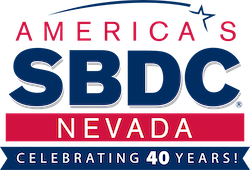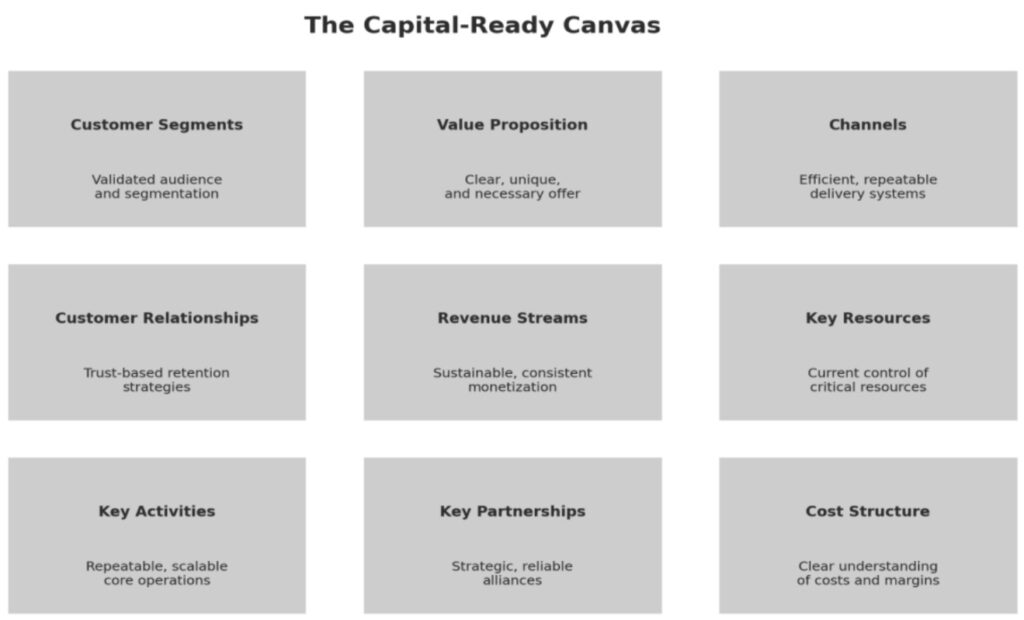Bridging Business Strategy and Entrepreneurial Capital-Readiness
Author: Gregory Grant, Entreprenologist
Introducing the Capital-Ready Canvas, a strategic adaptation of Alexander Osterwalder’s
Business Model Canvas, tailored for entrepreneurs seeking not just capital access but capital
readiness. By merging entrepreneurial philosophy with practical business model design,
this framework transforms the traditional nine building blocks into a capital-readiness
roadmap. Each segment of the canvas becomes a diagnostic point inviting entrepreneurs to
reflect on their clarity, capacity, and credibility before engaging capital. This manuscript
offers a new lens on how structure, philosophy, and strategic alignment form the foundation
of responsible capital engagement.
Introduction: From Access to Readiness
The entrepreneurship world has long been obsessed with one word: access. Access to
funding. Access to networks. Access to opportunity. While these are important, they are
insufficient. Access without readiness is like handing car keys to someone who has never
learned to drive. It is not a gift, it is a gamble.
This articulation proposes a shift: from access to readiness. Readiness is the internal
condition that allows an entrepreneur to receive, manage, and multiply capital responsibly.
It is the result of clarity, control, and credibility across all facets of a business.
To operationalize this philosophy, we adapt the well-known Business Model Canvas by
Alexander Osterwalder into a new framework called The Capital-Ready Canvas. Instead of
using the BMC purely as a design tool, we reimagine it as a diagnostic instrument, one that
measures an entrepreneur’s true preparedness for capital.
Rethinking the Business Model Canvas for Readiness
The Business Model Canvas (BMC) is a strategic tool designed to help entrepreneurs
visualize, test, and iterate their business models. Its nine segments provide a
comprehensive snapshot of how a business creates, delivers, and captures value.
But the BMC is more than a planning tool, it is a window into readiness. When each block is
viewed through the lens of capital engagement, it becomes a test of structure, discipline, and
strategic intent. The Capital-Ready Canvas builds on this concept by asking not just whether
a business model exists, but whether it is ready for outside capital.
The Nine Building Blocks as Readiness Indicators
Customer Segments
Readiness Question: Have you validated your audience?
Investors and lenders want specificity. Who exactly are you serving? Can you prove they
exist and are willing to pay? A capital-ready entrepreneur knows their primary and
secondary markets and can back it with evidence.
Value Proposition
Readiness Question: Is your offer both unique and necessary?
If your value proposition is unclear or undifferentiated, capital will accelerate confusion.
The market must not only want it, it must need it. Clarity and necessity are indicators of a
well-formed vision.
Channels
Readiness Question: How will your value reach your customers efficiently and repeatedly?
You must demonstrate delivery strength. If your channels are costly, inconsistent, or
unproven, readiness is compromised. Capital looks for systems that scale.
Customer Relationships
Readiness Question: Do you have a retention strategy, not just acquisition?
One-time buyers are not sustainable. Readiness includes a plan to create loyalty, feedback
loops, and long-term engagement.
Revenue Streams
Readiness Question: How do you make money and how consistent is it?
Capital readiness requires a monetization model that is logical, profitable, and ideally,
recurring. Unpredictable income is a red flag.
Key Resources
Readiness Question: What assets do you already control, people, systems, brand?
Readiness is not about what you will buy after funding. It is about what you already
steward. The presence of resources indicates capacity.
Key Activities
Readiness Question: What are the core activities that drive your model?
You must know what you do daily to create value. If your operations are unclear, capital will
expose your inefficiency.
Key Partnerships
Readiness Question: Who are your allies, vendors, and collaborators, and are they reliable?
Partnerships can extend capacity or create liability. Readiness means aligning with those
who strengthen your business, not drain it.
Cost Structure
Readiness Question: Do you understand your burn rate, margins, and cost drivers?
You must show that you understand your financial model. Clarity in cost structure helps
predict your capital needs and use.
Readiness Scores: A Diagnostic Layer
To make The Capital-Ready Canvas actionable, entrepreneurs can score each of the nine
segments on a scale from 1 (low readiness) to 5 (high readiness). This transforms the
canvas from a visual framework into a performance dashboard.
For example, if a business scores a 5 in Value Proposition but a 2 in Revenue Streams, it
reveals a gap between what they offer and how they monetize. This clarity enables strategic
focus. It also prepares the entrepreneur to answer difficult questions from funders with
confidence and honesty.
Rate your readiness for each component of your business model on a scale of 1 to 5:
1 = Not Ready • 2 = Somewhat Ready • 3 = Moderately Ready • 4 = Mostly Ready • 5 =
Fully Ready
Philosophy Behind the Canvas: Readiness Is Identity
Entrepreneurial Capital Readiness is not a checklist—it is a character. It is a reflection of
how deeply an entrepreneur understands their business, their value, and their
responsibility.
This canvas does not just measure readiness. It builds it. It forces entrepreneurs to confront
the hard questions before they are asked by others. It repositions entrepreneurship as a
practice of alignment—where internal structure matches external opportunity.
Ultimately, The Capital-Ready Canvas helps the entrepreneur answer a deeper question: Am
I someone capital can trust?
Use this checklist to assess your readiness across each of the nine blocks of your
business model.
Customer Segments
☐ Have I clearly identified and segmented my target customers?
☐ Do I have data to support the existence and demand of these segments?
Value Proposition
☐ Can I clearly articulate what makes my product/service unique?
☐ Is there proven market need for my offering?
Channels
☐ Do I have established, cost-effective methods to reach my customers?
☐ Can I consistently deliver my product/service?
Customer Relationships
☐ Do I have a defined strategy for building and maintaining customer relationships?
☐ Are there systems in place to encourage repeat business?
Revenue Streams
☐ Do I know how I make money and is it profitable?
☐ Are my revenue streams stable and recurring where possible?
Key Resources
☐ Do I currently control the essential resources (people, IP, systems)?
☐ Are my existing resources aligned with my business goals?
Key Activities
☐ Do I know the core operations that drive value in my business?
☐ Are these activities documented and repeatable?
Key Partnerships
☐ Have I identified and engaged reliable strategic partners?
☐ Do these partnerships add value and reduce risk?
Cost Structure
☐ Do I understand my fixed and variable costs?
☐ Can I accurately forecast and manage my expenses?
Capital Does Not Build Models, But Will Test It.
Capital is not a reward. It is a test. It does not build structure, it reveals it. Entrepreneurs
who pursue capital before building readiness often experience burnout, mission drift, or
public failure.
The Capital-Ready Canvas reframes funding as a function of preparedness, not persuasion.
It turns business modeling into a readiness ritual. Entrepreneurs who use this tool are not
just chasing checks, they are building vessels strong enough to carry vision. They are taking
responsibility for the full architecture of their business: the clarity of their value, the logic of
their delivery, the strength of their operations, the credibility of their relationships, and the
sustainability of their finances.
Capital-Readiness is not a destination. It is a habit. It is a way of thinking, building, and
refining. It is a posture of financial stewardship, choosing to be trustworthy with funding
opportunities, before the opportunity arrives. In this sense, readiness becomes identity.
Not just what you do, but who you are.
So here is your invitation:
• Do not wait for capital to force structure. Build it now.
• Do not wait for the pitch to define your model. Refine it now.
• Do not wait for performance pressure to reveal the cracks. Reinforce your
foundation today.
Use the Capital-Ready Canvas to interrogate your model deeply. Score your readiness
honestly. Identify what is strong and what needs attention. Develop a narrative that reflects preparation, not persuasion. Let this tool serve not just as a framework, but as a capital-ready mirror.
Because the truth is simple:
Capital will come when you are ready, not when you ask for it.
Build readiness, and capital will not be a chase. It will be a choice.
Book Recommendation
Osterwalder, A., & Pigneur, Y. (2010). Business model generation: A handbook for visionaries,
game changers, and challengers. Wiley.



